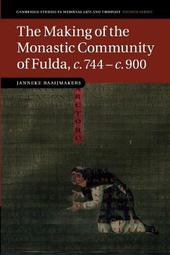
|
The Making of the Monastic Community of Fulda, c.744-c.900
Paperback / softback
Main Details
| Title |
The Making of the Monastic Community of Fulda, c.744-c.900
|
| Authors and Contributors |
By (author) Janneke Raaijmakers
|
| Series | Cambridge Studies in Medieval Life and Thought: Fourth Series |
|---|
| Physical Properties |
| Format:Paperback / softback | | Pages:378 | | Dimensions(mm): Height 230,Width 153 |
|
| Category/Genre | Church history |
|---|
| ISBN/Barcode |
9781107460201
|
| Classifications | Dewey:274.4102 |
|---|
| Audience | | Postgraduate, Research & Scholarly | |
|---|
| Illustrations |
3 Maps; 1 Halftones, unspecified; 4 Line drawings, unspecified
|
|
Publishing Details |
| Publisher |
Cambridge University Press
|
| Imprint |
Cambridge University Press
|
| Publication Date |
6 November 2014 |
| Publication Country |
United Kingdom
|
Description
The monastic community of Fulda was one of the most powerful institutions in early medieval Europe. This book traces the development of the community from its foundation in the 740s over one and a half centuries, a period richly documented by a variety of texts and archaeological remains. These sources reveal how Fulda's success forced the monks to rethink their goals and the ways in which they sought to achieve them. Its close connection to the Carolingian royal court also makes Fulda a fascinating case study of how local events influenced life in the palace and vice versa. The importance of Fulda and the rich array of sources associated with it have long been recognised, but this is the first full study, bringing together theology, architectural history and archaeology. The result is a vivid picture of life in this monastery and also in early medieval religious communities in general.
Author Biography
Janneke Raaijmakers is a Lecturer, Medieval History at the Universiteit Utrecht.
Reviews'Raaijmakers's meticulous study is of interest for graduate students and scholars interested in early medieval religion, the history of monasticism, or the complex relationships between religious institutions and the wider world.' Owen M. Phelan, Religious Studies Review
|